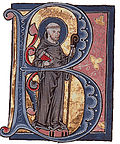Cistercian
The term Cistercian is used to refer to an order of Roman Catholic monks. Officially the order is called Ordo Cisterciensis (OCist), or Sacer Ordo Cisterciensis (SOC). These people follow the same rules as the Benedictines, that is to say those of St Benedict. Over time, the Benedictines made some changes to the rules and the way of life.
The Cistercians reject these. They went back to what St Benedict had taught. Sometimes their rules were more strict than those St Benedict had given. They also went back to manual labour, especially work in the fields. Because of this, the Cistercians helped spread technologies around Medieval Europe. In 1882 certain monasteries formed a new order, called the Trappists. With time, they split completely from the Cistercians.
Cistercian Media
St. Bernard of Clairvaux, one of the most influential early Cistercians, seen here depicted in a historiated initial
Vietnamese Cistercian monks standing in a cloister and wearing their religious habits
Saint Benedict and Saint Bernard (1542), by Diogo de Contreiras. Saint Bernard is depicted in the white cowl of the Cistercians.
The ruins of Melrose Abbey, mother house of the Cistercians in Scotland
The houses affiliated with the Abbey of Savigny merged with the Cistercian Order.
A plan of Cîteaux Abbey in the 16th century.
Cistercian abbey in Bélapátfalva, Hungary








